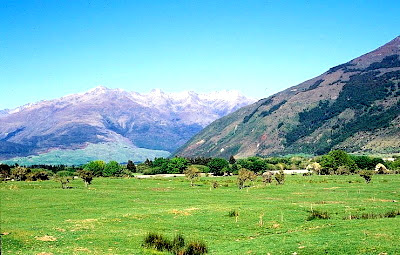New Zealand No.4
This continues from my last 3 postings on our 6 week trip to New Zealand in 2005. It is not a full detailed trip report and we haven't placed it in any order of birds and dates. All photographs were taken by ourselves.
Approaching Lindis Pass, looked an interesting birding site.
Lindis Pass - only spent a short time here, disappointing for birds.
Doreen photographing at Lindis Pass.
White-faced Heron Egretta Novaehollandae
White-faced Heron has 2 subspecies and is now a common bird, although it is a fairly new arrival to New Zealand, when it arrived in the 1940's. It has a large range throughout most of Australia also in New Guinea and Indonesia. It has also been recorded on some of the Sub-Antarctic Islands off New Zealand.
Two views on a short stop at Knights Point on our way to Haast.

Two views of the road leading up to Haast
Looking back towards Haast Pass
Terrible picture of a Yellowhead taken at Haast pass.
Yellowhead is endemic to South Island. Once a common forest bird, it has now declined drastically since the introduction of rats and stoats and it is now classified as endangered.
We were fortunate to find two pairs building nests near the bridal track on Haast Pass. We also had several on Ulva Island where the Dept. of Conservation have released some onto Ulva Island as this island is now predator-free. The above picture was taken in a very dark forest.
We now had a longish drive to Twizel.

Lake Wanaka - We stopped here to purchase some provisions in the
town and we had superb views of a New Zealand Falcon which
flew around the shore passing us within 10 metres.
Two views looking towards Mt. Cook.
White-headed (Pied) Stilt Himantopus leucocephalus
White Headed (Pied) Stilt has a large distribution from Sumatra, Java, Sulawesi, Papua New Guinea Australia and New Zealand. Still considered by some checklists to be a sub species of Black-winged Stilt.
Black Stilt Himantopus novazelandiae We spent 3 days looking for Black Stilts, as in 2020 there were only 169 adults left. We saw several hybrids and on one day we decided to visit Mt. Cook village. On our drive up we could look down on the edge of a braided river with exposed mud, and were surprise to find virtually the whole of the world population feeding on the mud. Although they are to far for photography we had our telescope with us and enjoyed some good scope views. After we visited Mt. Cook village, on the drive back the birds were still present.
Double Banded Plover Charadrius bicinctus
Double Banded plover along the braided river at Omarama.
Double Banded Plover has two subspecies and occurs in both Australia and New Zealand. We only recorded it in the Twizel area with a daily maximum of 40.
Wrybill Anarhynchus frontalis
Wrybill along the braided river.
We were delighted to find our first ever Wrybill along the braided river. Its endemic to New Zealand and is classified as vulnerable with a world population estimated between 2,000 to 5,000 birds. It breeds on South Island and winters chiefly on North Island.
Paradise Shelduck Tadorna variegata
Paradise Shelduck with young
Female Paradise Shelduck
Male Paradise Shelduck
Paradise Shelducks are endemic to New Zealand. Widely distributed on both North and South Islands and also some of the offshore islands.
.





















